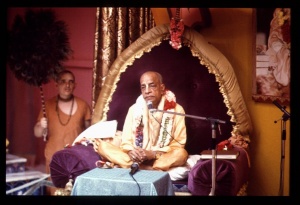SB 3.21.8: Difference between revisions
m (1 revision(s)) |
No edit summary |
||
| Line 1: | Line 1: | ||
{{info | {{info | ||
|speaker=Maitreya | |speaker=Maitreya Ṛṣi | ||
|listener=Vidura | |listener=Vidura | ||
}} | }} | ||
[[Category:Srimad-Bhagavatam - Canto 03 Chapter 21|S08]] | |||
[[Category:Bhagavatam Verses Spoken by Maitreya Rsi - Vanisource|032108]] | |||
<div style="float:left">'''[[Srimad-Bhagavatam]] - [[SB 3|Third Canto]] - [[SB 3.21: Conversation Between Manu and Kardama|Chapter 21: Conversation Between Manu and Kardama]]'''</div> | |||
<div style="float:right">[[File:Go-previous.png|link=SB 3.21.7]] '''[[SB 3.21.7]] - [[SB 3.21.9]]''' [[File:Go-next.png|link=SB 3.21.9]]</div> | |||
{{RandomImage}} | |||
==== TEXT 8 ==== | ==== TEXT 8 ==== | ||
<div | <div class="verse"> | ||
tāvat prasanno bhagavān | :tāvat prasanno bhagavān | ||
puṣkarākṣaḥ kṛte yuge | :puṣkarākṣaḥ kṛte yuge | ||
darśayām āsa taṁ kṣattaḥ | :darśayām āsa taṁ kṣattaḥ | ||
śābdaṁ brahma dadhad vapuḥ | :śābdaṁ brahma dadhad vapuḥ | ||
</div> | </div> | ||
| Line 16: | Line 22: | ||
==== SYNONYMS ==== | ==== SYNONYMS ==== | ||
<div | <div class="synonyms"> | ||
''tāvat''—then; ''prasannaḥ''—being pleased; ''bhagavān''—the Supreme Personality of Godhead; ''puṣkara-akṣaḥ''—lotus-eyed; ''kṛte yuge''—in the Satya-yuga; ''darśayām āsa''—showed; ''tam''—to that Kardama Muni; ''kṣattaḥ''—O Vidura; ''śābdam''—which is to be understood only through the ''Vedas''; ''brahma''—the Absolute Truth; ''dadhat''—exhibiting; ''vapuḥ''—His transcendental body. | |||
</div> | </div> | ||
| Line 23: | Line 29: | ||
==== TRANSLATION ==== | ==== TRANSLATION ==== | ||
<div | <div class="translation"> | ||
Then, in the Satya-yuga, the lotus-eyed Supreme Personality of Godhead, being pleased, showed Himself to that Kardama Muni and displayed His transcendental form, which can be understood only through the Vedas. | Then, in the Satya-yuga, the lotus-eyed Supreme Personality of Godhead, being pleased, showed Himself to that Kardama Muni and displayed His transcendental form, which can be understood only through the Vedas. | ||
</div> | </div> | ||
| Line 30: | Line 36: | ||
==== PURPORT ==== | ==== PURPORT ==== | ||
<div | <div class="purport"> | ||
Here two points are very significant. The first is that Kardama Muni attained success by yoga practice in the beginning of Satya-yuga, when people used to live for one hundred thousand years. Kardama Muni attained success, and the Lord, being pleased with him, showed him His form, which is not imaginary. Sometimes the impersonalists recommend that one can arbitrarily concentrate one's mind on some form he imagines or which pleases him. But here it is very clearly said that the form which the Lord showed to Kardama Muni by His divine grace is described in the Vedic literature. Śābdaṁ brahma: the forms of the Lord are clearly indicated in the Vedic literature. Kardama Muni did not discover any imaginary form of God, as alleged by rascals; he actually saw the eternal, blissful and transcendental form of the Lord. | Here two points are very significant. The first is that Kardama Muni attained success by ''yoga'' practice in the beginning of Satya-yuga, when people used to live for one hundred thousand years. Kardama Muni attained success, and the Lord, being pleased with him, showed him His form, which is not imaginary. Sometimes the impersonalists recommend that one can arbitrarily concentrate one's mind on some form he imagines or which pleases him. But here it is very clearly said that the form which the Lord showed to Kardama Muni by His divine grace is described in the Vedic literature. ''Śābdaṁ brahma:'' the forms of the Lord are clearly indicated in the Vedic literature. Kardama Muni did not discover any imaginary form of God, as alleged by rascals; he actually saw the eternal, blissful and transcendental form of the Lord. | ||
</div> | </div> | ||
__NOTOC__ | |||
<div style="float:right; clear:both;">[[File:Go-previous.png|link=SB 3.21.7]] '''[[SB 3.21.7]] - [[SB 3.21.9]]''' [[File:Go-next.png|link=SB 3.21.9]]</div> | |||
__NOTOC__ | |||
__NOEDITSECTION__ | |||
Revision as of 12:18, 6 May 2021

A.C. Bhaktivedanta Swami Prabhupada
TEXT 8
- tāvat prasanno bhagavān
- puṣkarākṣaḥ kṛte yuge
- darśayām āsa taṁ kṣattaḥ
- śābdaṁ brahma dadhad vapuḥ
SYNONYMS
tāvat—then; prasannaḥ—being pleased; bhagavān—the Supreme Personality of Godhead; puṣkara-akṣaḥ—lotus-eyed; kṛte yuge—in the Satya-yuga; darśayām āsa—showed; tam—to that Kardama Muni; kṣattaḥ—O Vidura; śābdam—which is to be understood only through the Vedas; brahma—the Absolute Truth; dadhat—exhibiting; vapuḥ—His transcendental body.
TRANSLATION
Then, in the Satya-yuga, the lotus-eyed Supreme Personality of Godhead, being pleased, showed Himself to that Kardama Muni and displayed His transcendental form, which can be understood only through the Vedas.
PURPORT
Here two points are very significant. The first is that Kardama Muni attained success by yoga practice in the beginning of Satya-yuga, when people used to live for one hundred thousand years. Kardama Muni attained success, and the Lord, being pleased with him, showed him His form, which is not imaginary. Sometimes the impersonalists recommend that one can arbitrarily concentrate one's mind on some form he imagines or which pleases him. But here it is very clearly said that the form which the Lord showed to Kardama Muni by His divine grace is described in the Vedic literature. Śābdaṁ brahma: the forms of the Lord are clearly indicated in the Vedic literature. Kardama Muni did not discover any imaginary form of God, as alleged by rascals; he actually saw the eternal, blissful and transcendental form of the Lord.